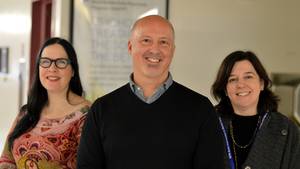People with inflammatory conditions, such as rheumatoid arthritis, are usually treated with medications that normally help calm arthritis, causing their joint symptoms to diminish or disappear completely.
However, despite many treatments, they are not effective for all patients and are in some cases associated with side-effects on top of persistent inflammation — the body’s process of fighting against things that harm it, such as infections, injuries, and toxins, in an attempt to heal itself.
This has led researchers in Halifax to take a closer look at how and why patient responses to treatment vary.
Working together, health researchers from the QEII Health Sciences Centre, Dalhousie University and the IWK Health Centre are leading an international team of physicians and scientists to investigate the role inflammation plays in conditions like rheumatoid arthritis — the most chronic, long-term inflammatory type of arthritis.
The Restitution Enhancement in Arthritis and Chronic Heart Disease (REACH) study — funded by the Canadian Institutes of Health Research (CIHR), The Arthritis Society and local funding support — is a Dalhousie University-based research initiative funding various projects, with a common goal of understanding how inflammation resolves. The study began in 2015.
“We’re very fortunate to have clinician investigators, as well as basic scientists, who were able to come together to make a compelling application,” says Dr. Jean Marshall, professor in the Department of Microbiology and Immunology at Dalhousie University.
The contrast in patient outcomes fuelled the group’s desire to determine the differences between people who suffer from ongoing inflammation and those who do not. Their goal is one that could help physicians identify the best treatments for individual patients.
Dr. John G. Hanly, attending staff rheumatologist at the QEII and professor in the Division of Rheumatology at Dalhousie University, identified 150 newly diagnosed rheumatoid arthritis patients presenting with pain, swelling and disability involving multiple joints for the first time, and enrolled these patients in the study.
Agreeing to share medical information about their arthritis and provide their blood for examination, the experiences of the patients participating in the study were otherwise similar to the clinical care received by those not in the study.
The study’s major findings resulted from an extensive investigation of the immune system through blood samples collected from these patients. Researchers found that the patients who didn’t improve had a different type of immune response in their peripheral blood — red blood cells, white blood cells and platelets.
Although not everyone improved with anti-inflammatory and immune-modifying therapies, this observation has been extremely useful, showing a different pathway exists in about half of the patients.
“That’s really the clinical issue: to better understand which drugs will work in which individual patient,” says Dr. Hanly, who notes rheumatoid arthritis costs the Canadian healthcare system millions annually. “It’s a bit of a holy grail in this area of medicine right now and these sorts of studies are designed to try to unravel that.”
Results of the study were published in Arthritis & Rheumatology in July 2020. While the results are preliminary, the team believes the research findings could be advantageous to future research in identifying the best treatment for patients.
“It’s one piece that helps support the goal of getting patients on the best treatment as early as possible, personalizing the treatment,” says Dr. Thomas Issekutz, professor of immunology at Dalhousie University
and Department of Pediatrics.
Dr. Marshall likens their field of study to a puzzle.
“You’ve got this big jigsaw puzzle, which is us trying to understand the disease and how to get the best therapy for it,” says Dr. Marshall. “What this study has done has shone a light on a particular part of that jigsaw puzzle and showed there’s a greater likelihood of finding something in this part of the jigsaw puzzle than many other parts. It tells us where to look.”
While they remain hopeful, further research is needed. “I don’t think we’re at a stage where we can say we can use this as a marker to predict a response or no response,” says Dr. Hanly. “This is a step forward in trying to personalize and match the correct therapy for the correct patient as early as possible in the disease.”
“Of course, these are early studies, so a larger population of patients still needs to be investigated to confirm or substantiate these results,” says Dr. Issekutz. “But there is literature coming out from other laboratories supporting what we’ve found as well.”
Noting a strong tradition of collaboration between the QEII, Dalhousie University and the IWK, the team says the medical community is fortunate to include many researchers, investigators and clinician scientists with an interest in inflammation.
“There are unique opportunities in this environment for clinicians and basic scientists, who approach the same problem from different perspectives, to work collaboratively together,” says Dr. Hanly. “You don’t have to go to Harvard or Toronto to see that level of successful research come to fruition; it’s happening right here in Nova Scotia.”
“Programs such as this enhance education and training of younger residents and students to understand the latest in the research and treatment of these diseases and foster the provision of cutting-edge medical care,” says Dr. Issekutz. “That research synergizes with the clinic by bringing new innovations to patients in a timely manner.”
Meanwhile, the team members, who collectively have more than 100 years of experience in their respective fields, have seen the progress of therapies for rheumatoid arthritis throughout the decades and remain hopeful their preliminary study will lead to greater advancement in treatment.
“We certainly have a bright future for continuing this type of collaborative research between the hospitals and the university in this area,” says Dr. Marshall. “The experience we’ve had, which has been quite positive, is something we can build upon.”








